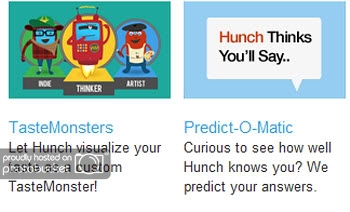In November of last year, eBay Inc. announced its acquisition of Hunch, a well-known startup focused on recommendation technology.Hunch’s patented prediction technology – also known as a “taste graph” – uses signals from around the web to map members with their predicted affinity for products, services, other people, websites or just about anything, and then customizes recommended topics for them.

Chris Dixon, Hunch’s founder, is a recognized expert on recommendation technology and is currently working on integrating the technology with eBay. He is also the author of a very widely followed blog. The Hub caught up with Chris for an interview on Hunch’s present and future at eBay Inc. Here are his thoughts.
Please tell us what you and the Hunch team are working on now that you’re part of eBay Inc., especially regarding any technology integration projects that might be underway.
We’re focused on personalizing eBay to make it even better for both buyers and sellers. To do that, we’re working on both back-end, “behind the scenes” recommendation technology as well as new front-end layout ideas to present those recommendations to eBay users. The net goal is to create a better, more customized experience for both buyers and sellers across all eBay sites.
What is unique about Hunch’s recommendation technology, and how did it evolve?
Many recommendation technologies use what’s called Collaborative Filtering to predict what you might like based on the purchase patterns of other people who looked at, or bought, something that you purchased. Other sites, like Netflix or Pandora, ask you to rate things in a particular vertical segment (movies or music in these cases) and then make predictions based on that.
Our approach is broader. Our algorithms look across verticals and also try to get a deep sense of the underlying factors that inform our individual choices. As an example, you could probably do a pretty good job of suggesting a book I’d like if you knew something about my demographic, personality, beliefs, etc. in addition to knowing something about my past preferences for movies, TV shows or other books. None of us is one-dimensional, and that’s why we think a multi-dimensional approach to this challenge is what’s needed.
Our Taste Graph includes predicted information on about 500 million people, 200 million items (a book, movie, gadget, or whatever), and 30 billion connections between people and items. One of the challenges we faced as our data grew was how to process it and manipulate in order to get accurate predictions in near real-time. Our solution was to transform each person’s tastes into a manageable 50 numbers. Think of it as an individual Taste Fingerprint extracted from the larger Taste Graph.
For some people, recommendation technology raises concerns about user privacy issues. What is Hunch’s stance on these?
This is something we’ve thought about a lot. We’ve always believed in having a transparent social contract with our users that gives them control of their data, provides them easy ways to delete or change it and ultimately provides them with real value in return for telling us about themselves.
The value proposition with Hunch is pretty clear: Tell us about yourself, and you’ll get great recommendations that are tailored to your taste. And you’ll probably have some fun in the process, because we’ve tried to make the site’s questions fun and engaging rather than seeming like they were written by someone in a white lab coat. On average, a Hunch user answers more than 100 of our “Teach Hunch About You” questions on the site, which is a pretty amazing level of engagement and a testament to how much people are willing to share when they feel they’re receiving value in return.
In addition to providing a value payoff at the individual level, we’ve also worked to create reports and infographics based on insights from our aggregate and anonymized data. It’s another way to reinforce what we’re about and to provide value back to our users.
What do you see in the future for Hunch at eBay Inc.? For example, as the company partners with retailers on multichannel solutions, could Hunch’s recommendations be of value to them?
Most of our focus in the near term is creating better merchandising recommendations for buyers, but there’s also lots of opportunity on the seller side. For example, it would be great to be able to show sellers the profiles of their customers. That could inform their inventory offerings, the content they use to describe the inventory and maybe even the outside advertising vehicles they use to cross-promote their eBay listings. Hunch’s data can provide these types of insights. Here’s an example we did using Hunch data to profile eBay users in aggregate.
Multichannel/offline is also promising over time, in that Hunch’s predictions can provide actionable marketing insights and predictive suggestions for inventory optimization and merchandising effectiveness.
You have a very influential and widely read blog. Has it helped you launch useful conversations with people in the technology community and has it provided other benefits?
Thanks. We actively encourage all of our employees to have blogs and to share their expertise about their functional areas.
I started my own blog a few years ago, because I wanted to share some of my own experience about founding and investing in startups with other entrepreneurs. I’ve met a lot of great people in the process, and it’s also great to see readers exchange ideas with each other in comments.
